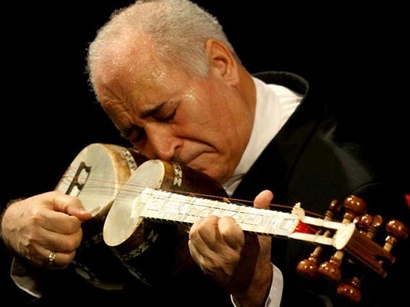Azerbaijani tar becomes part of world cultural heritage

By Nigar Orujova
Music and craftsmanship of Azerbaijani tar, one of the ancient stringed instruments, was included in the UNESCO list during the seventh session of the UNESCO Intergovernmental Committee for the Safeguarding of Intangible Cultural Heritage, held in Paris on December 3-7.
The tar, a long-necked plucked lute, is one of the most important musical instruments in Iran and the Caucasus. The tar is traditionally crafted and performed throughout Azerbaijan, which is signified by its depiction on the Azerbaijani national banknote of one manat nominal value.
Inclusion of music featuring Azerbaijani national instrument tar into the UNESCO Representative List of the Intangible Cultural Heritage of Humanity is of particular importance, Culture Minister Abulfas Garayev said on December 11 during an event held on this occasion.
"Azerbaijani tar, which is the Azerbaijani musical foundation, is now preserved by humanity and has entered the intangible cultural heritage list," Garayev said.
"Every notion added recently to the UNESCO Representatives List is very important for us. The UNESCO list already includes Novruz holiday, Azerbaijani mugham, Azerbaijani ashug art and Azerbaijani carpet. These are all the kinds of art created by Azerbaijani people," Garayev stressed.
Today Azerbaijani tar occupies a worthy place in national music and in the XX-XXI century Azerbaijani music pallette, the minister said.
The UNESCO session decided to hold the eighth session of the Committee, as well as the tenth anniversary of the Convention for the Safeguarding of the Intangible Cultural Heritage, in Baku on December 2-8, 2013. The next session of the Committee will be chaired by the Azerbaijani Ministry of Culture and Tourism.
The UNESCO list of intangible cultural heritage, which was established in 2008, when the mentioned Convention took effect, aims to draw attention to the importance of better protection of such cultural heritage samples worldwide and to ensure public awareness on their significance.
Melody of soul
The word tar came from Persian language meaning "string", and is encountered in the works of prominent Azerbaijani writers and poets including Gatran Tabrizi, Nizami and Mohammed Fizuli.
The Azerbaijani tar had been forming and developing for centuries based on ancient stringed musical instruments presumably shared with the Persian Empire, however, it differs from the Iranian tar in terms of shape, size, number of strings, technique of performance and tones.
In the early 1870s, the Azerbaijani tar went through a re-birth and became a popular national musical instrument with the help of the famous Azerbaijani tar player from Karabakh, Mirza Sadig. Sadig or Sadikhjan developed the old Persian 5-6 string-tar and created the new version of this musical instrument, which later became known as the Azerbaijani tar or the Caucasus tar.
The modern Azerbaijani tar invented by Sadikhjan has 11 strings and 17 tones. By reducing the size of the instrument, Sadikhjan also developed a new manner of playing the instrument and for the first time presented the play on a tar nestled to the chest, while early-time tar players held the instrument to their knees.
Azerbaijani tar craftsmanship begins with careful selection of material for the instrument with different sorts of wood for its parts: mulberry wood for the body, nut wood for the neck, and pear wood for the tuning pegs. There are 11 metal strings of different diameter divided into three groups in a tar. They are sounded with a small "mizrab" (a plectrum worn on the player's finger) made of bone or ebonite.
Using various tools, crafters create a hollow body in the form of a figure eight, which is then covered with thin pericardium of an ox. The fretted neck is affixed, metal strings are added and the body is inlaid with mother-of-pearl.
Performers hold the instrument horizontally against the chest and pluck the strings with a plectrum, while using trills and a variety of techniques and strokes to add color to the tunes.
For centuries, tar performance has held an essential place in weddings and different social gatherings, festivities and concerts in Azerbaijan. Players have been passing on their skills to young people within their community.
Craftsmanship and performance of the tar and the skills related to this tradition play a significant role in shaping the cultural identity of Azerbaijanis.
Uzeyir Hajibayov, a great Azerbaijani composer of the first mugham (folk music) opera, referring to the tar's technical performance capabilities, wrote that tar is the most valuable and most important musical instrument, which enhances musical education of the Orient.
Tar was used mainly in the structure of the mugham trio (tar, kamancha and tambourine) as a lead instrument, but it can also be used in solo performances. Tar plays a significant role in the development of mugham art today. In mugham operas solo singing is performed with the accompaniment of the tar. Azerbaijani composers wrote many major concerts with the use of the tar and the orchestra.
There are a number of outstanding Azerbaijani tar players including Gurban Pirimov, Aliaga Guliyev, Ahmad Bakikhanov, and Haji Khanmammadov.
Another prominent tar player, Bahram Mansurov, was the art director and the first tar player of the Azerbaijan State Academic Opera and Ballet Theater for over 30 years. Ramiz Guliyev, a living master of this art, continues to give concerts and popularize the Azerbaijani tar around the world.
Here we are to serve you with news right now. It does not cost much, but worth your attention.
Choose to support open, independent, quality journalism and subscribe on a monthly basis.
By subscribing to our online newspaper, you can have full digital access to all news, analysis, and much more.
You can also follow AzerNEWS on Twitter @AzerNewsAz or Facebook @AzerNewsNewspaper
Thank you!
